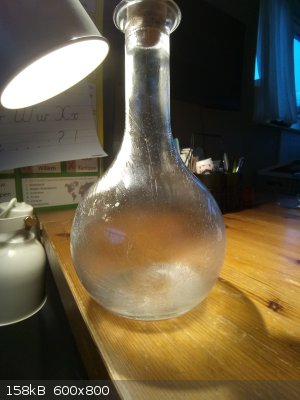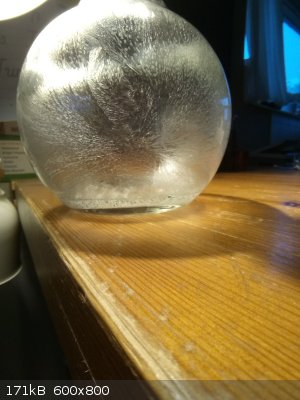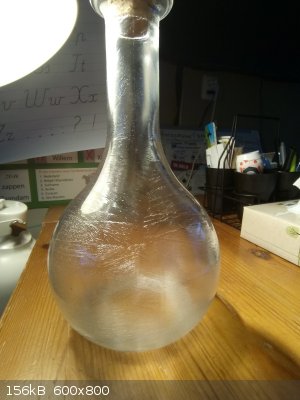teodor
National Hazard
   
Posts: 876
Registered: 28-6-2019
Location: Heerenveen
Member Is Offline
|
|
Chemical demonstration: accurate wind direction detection with tert-butanol
I think this could be a nice mixed chemical/physical demonstration for children of all ages.
On Sunday evening I played with a bottle containing a small amount of tert-butanol.

There is nothing special about this compound except its convenient melting point around 25C which allows observing of thawing and freezing of the
liquid in the bottle. It is very sensitive, so when you put the bottle close to your body it starts to thaw. And when not disturbed in a room it
freezes forming nice asterisks on the bottle walls.
But when you put it outside the effect is different. The crystals which are formed in this case always grow in the direction of wind streams. So you
can see where the wind touches the bottle:

and where it leaves it:

The same effect could be observed by putting the bottle under stream of cold water.
[Edited on 6-12-2021 by teodor]
|
|
|
Ubya
International Hazard
    
Posts: 1247
Registered: 23-11-2017
Location: Rome-Italy
Member Is Offline
Mood: I'm a maddo scientisto!!!
|
|
Couple that with a storm bottle and you have a nearly complete weather station.
Glacial acetic acid also is solid when cold, have you experienced the same effect using that?
---------------------------------------------------------------------
feel free to correct my grammar, or any mistakes i make
---------------------------------------------------------------------
|
|
|
teodor
National Hazard
   
Posts: 876
Registered: 28-6-2019
Location: Heerenveen
Member Is Offline
|
|
I did a few experiments with GAA but it doesn't form needle-like crystals in those conditions.
Also, I was unable to reproduce the experiment with the same bottle and the cold water after several days - it didn't precisely follow the direction
of the water stream but formed star-like centers. There are 2 possible explanations:
1) the alcohol absorbed some water through the cork which affected the crystallization;
2) the glass temperature was slightly different compared to my first series of experiments.
|
|
|
teodor
National Hazard
   
Posts: 876
Registered: 28-6-2019
Location: Heerenveen
Member Is Offline
|
|
Now I understand why it happens with pure tert-butanol but works neither with glacial acetic acid nor with tert-butanol contaminated with water.
This experiment requires a compound with a sharp melting point.
The mechanism which forces the crystals to grow in the direction of the wind (or water) streams is the following:
1. The crystallization starts at the coldest area (where the wind or water touches the bottle).
2. Then the freezing proceeds in the direction of temperature changes (gradient), and the crystals grow exactly in this direction.
When the compound is not pure it has no sharp melting point which causes several centers of crystallization to be formed around the coldest place, and
the pattern becomes disturbed.
For this reason, the experiment can be performed only with pure compounds.
|
|
|